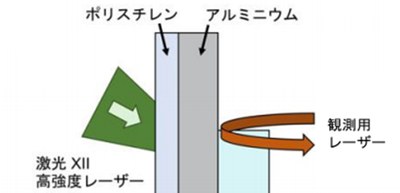
Optical properties of diamond under pressure clarified
Diamond, a unique material with the highest hardness of any known mineral, as well as high transparency and refractive index, is used in the fields of material science, planetary science, and laser fusion engineering. However, its high-pressure behaviors for applications and its optical properties, such as transparency and refractive index under pressure, were not fully understood.
Natural diamonds are formed deep below the earth's surface under intense heat and high pressure as well as during the fiery instant when meteors and meteorites slam into Earth. Thus, high-intensity pulse laser-driven shock compression is the only method for investigating the physical properties of extremely hard diamonds.
In order to examine changes in optical properties of diamond under pressure, a group of researchers from Osaka University and the Center for High Pressure Science and Technology Advanced Research (HPSTAR) in China measured the optical properties of diamond in shock wave experiments using high-intensity pulse lasers in the pressure range of 60-550 GPa.
The experiments were conducted using the Gekko XII laser at the Institute of Laser Engineering of Osaka University. Strong shock waves were driven in a sample with the bundled 12 laser beams, which were focused on a laser spot of 1mm in diameter. The Gekko XII laser is capable of generating terawatt and petawatt output energy compressed into pulses in the short duration of 100 fs.
In shock wave experiments at ambient conditions, the researchers observed that diamond turned opaque during the compression process in real time and that the refractive index of single-crystal diamond increased as density increased to the limit of its transparency in contrast to previous static reports on continuous decrease of refractive index.
As a laser with a pulse width of about 5 ns was used in the experiments, the duration of the shock-compressed state of a sample was limited to a few nanoseconds. To perform this experiment successfully, it was necessary to determine the shock-compressed state of the diamond during this considerably short time and measure its optical properties.
Thus, the researchers measured shock wave velocity by VISAR (Velocity Interferometer System for Any Reflector) in the pressure regime between 60 and 550 GPa, obtaining transparency and refractive index of single-crystal diamond compressed within nanoseconds while determining the shock-compressed states of diamond.
In this study, pressure over 170 GPa was applied to diamond through shock compression. At shock pressures between 90 and 170 GPa, diamond was transparent during the compression process, then gradually turned opaque during the subsequent release process and at pressures greater than 171 (±12) GPa, diamond turned opaque during the compression process.
The refractive index of single-crystal diamond monotonically increased as density increased to the limit of its transparency. This means that light absorption coefficients and refraction index of diamond, which is thought to be formed during a shock wave from an asteroid collision, significantly changed during that process.
The optical properties of diamond clarified in this study will contribute to the further development of high-pressure science. Recently, a compression technique combining a laser shock with a sample pre-compressed by diamond-anvil cell (DAC), in which a sample is compressed between two opposing diamonds, has drawn attention. Since VISAR measurements are performed via this method as well, information about transparency and refractive rate of diamond is essential for determining the compression state of a sample with a high degree of accuracy. The optical features of diamond clarified in this study will also be helpful in these types of high-pressure experiments.
Figure 1
The article, "Optical properties of shock-compressed diamond up to 550GPa," was published in Physical Review B at DOI: https://journals.aps.org/prb/abstract/10.1103/PhysRevB.101.184106#fulltext.
Related Links
Kodama Laboratory, Graduate School of Engineering, Osaka University (link in Japanese)
